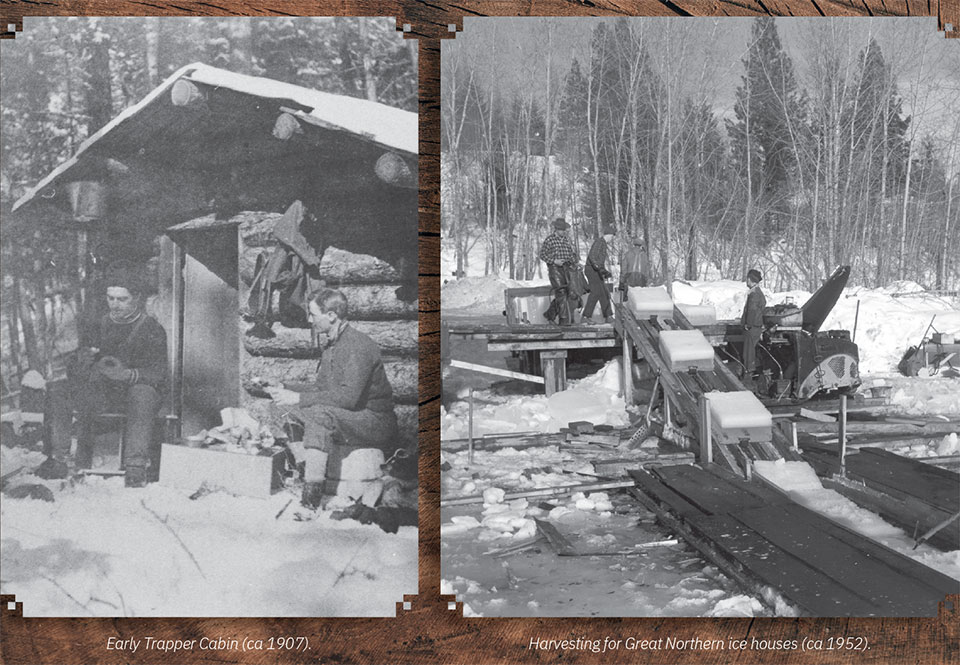From Rustic…to Resort
by Cassidy Mantor |
photos courtesy Stumptown Historical Society
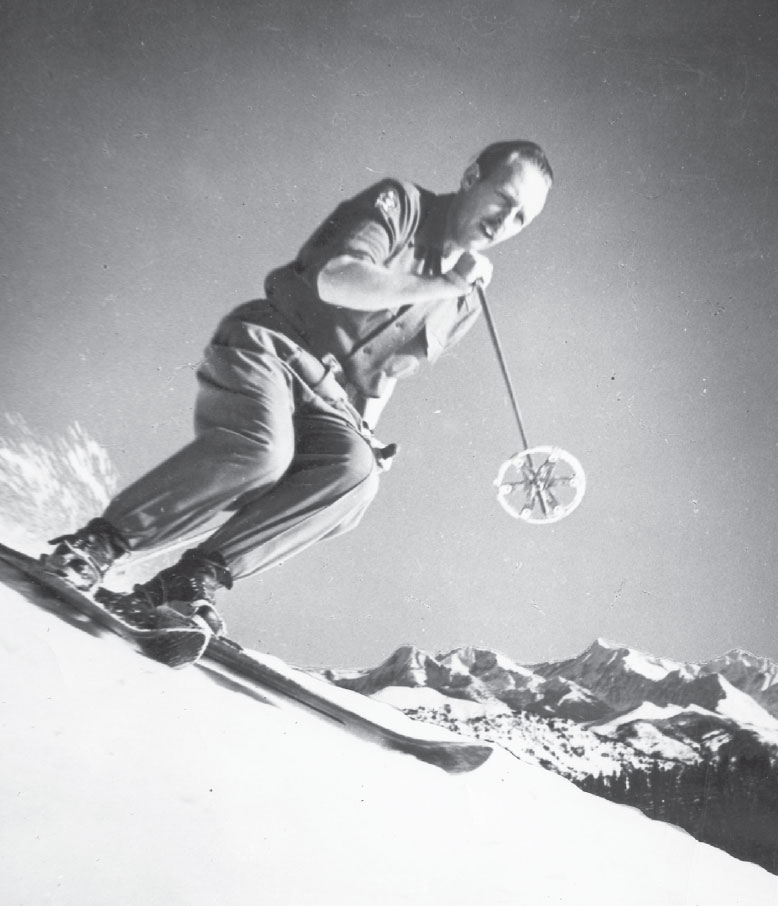
Great Falls businessman Ed Schenck (ca 1950) quickly recognized the area’s potential and shortly after World War II, began efforts to develop a full-fledged ski resort on the mountain.
Named one of the top 25 ski towns by National Geographic, it’s easy to see why Whitefish, Montana, is so special. With year-round recreational opportunities for skiing, boating, biking, and hiking from Whitefish Mountain Resort to Glacier National Park, not to mention art galleries, coffee houses, and a growing live music scene, Whitefish and its neighboring towns of the greater Flathead Valley are some of the best places in the Big Sky.
Long before it became the resort destination of today, archaeological records indicate the Salish, Kootenai, and Pend d’Oreille tribes shared hunting grounds in western Montana, Idaho, and Washington. The first white trappers arrived in the region in the 1850s and they named the lake Whitefish after seeing Native Americans pulling white fish from the lake.
In 1883, the first white settler, John Morton, built a cabin on Whitefish Lake near the mouth of the Whitefish River. Soon after, the Hutchinson brothers and the Baker brothers – loggers from Michigan – joined Morton. Virgin forest surrounded a beautiful yet wildly rugged place. The Stumptown Historical Society notes a diary entry from W. O. Hutchinson that revealed his journey took him five days to travel 35 miles from the nearest train stop to the town. Ultimately, the Bakers and the Hutchinsons were the ones who cleared the forest for the future town’s site and built Whitefish.
When the Boston & Montana (B&M) Commercial Company opened in the 1890s, loggers began floating their logs down the river to Kalispell deeper into the Flathead Valley. During the logging heyday, records referred to the town as “Stumptown” for the stumps that were left behind.
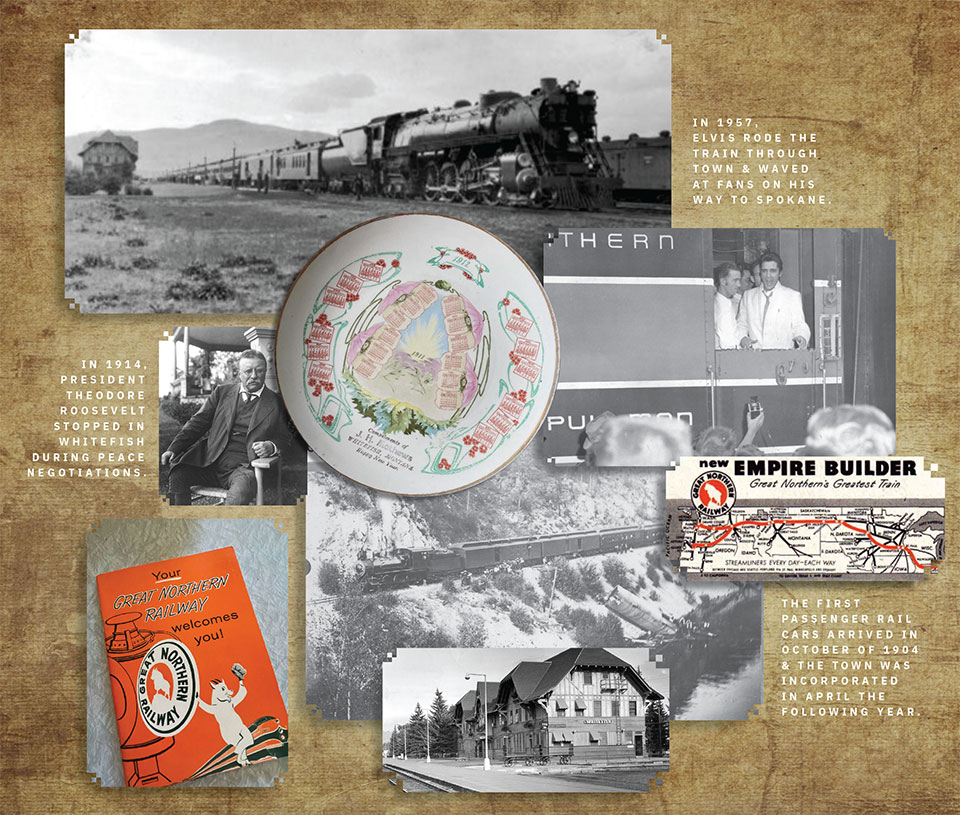
In 1891, West Glacier got a stop on the Great Northern Railway. In Kalispell on New Year’s Day of 1892, 3,500 people celebrated the new tracks running through town linking the Flathead Valley to St. Paul and west to the Pacific Ocean. Unfortunately, the terrain through the Salish mountains west of Kalispell was too steep, so crews were sent back to establish a different route through western Montana. Two new stops were added, one up north in Eureka and a new regional headquarters at the south end of Whitefish Lake. The rail industry still provides 400 jobs in town. Two Amtrak passenger trains stop in Whitefish each day, and dozens of freight trains pass through town running on Burlington Northern/Santa Fe tracks from Seattle to Chicago.
Also in 1892, C. E. Ramsey built a hotel in Whitefish to host sportsmen and women coming into town on horseback from Columbia Falls and Kalispell. Dancing, fishing, boating, and croquet were the draws. While life was hard in the early years of establishing the pioneer town, it was peppered with old-fashioned nice moments too: baseball and horseshoes, home-baked goods, and school dances.
Whitefish was the wild west during its early years. Smallpox raged, and while there were only two recorded hangings, bank robberies, rail crimes, and hunting accidents were commonplace. Stumptown Historical Society’s records indicate that on one night in June, 1904, residents were awakened by an explosion caused by a blown safe on the rail platform and broken windows at the depot. Luckily a rail car with “giant powder” that had been stopped at the depot had moved on the day before, otherwise, the entire town might’ve been blown up.
Before Bigfork became the unofficial headquarters for the Fourth of July in the Flathead, Whitefish began hosting organized celebrations as early as 1908. The inaugural Whitefish celebration lasted three days with the city’s band and patriotic speeches, boat races, a tug-of-war between railroad workers, and a baseball game between Whitefish and Columbia Falls. (Whitefish won, 19-8.) Perhaps most memorable were the events organized by the Japanese contingent in town, which had arrived for work on the railroad. Their athletes did ju-jitsu demonstrations and hosted a pyrotechnic lantern parade.
The first passenger rail cars arrived in October of 1904 and the town was incorporated in April the following year. A significant portion of Japanese arrived after the Russo-Japanese war, and President Theodore Roosevelt further put Whitefish on the map by stopping at Whitefish during peace negotiations. In 1914, Whitefish’s first student graduated from the new high school. The following year, the school board voted to build stables for the students’ horses. In 1957, Elvis rode the train through town and waved at fans on his way to Spokane.
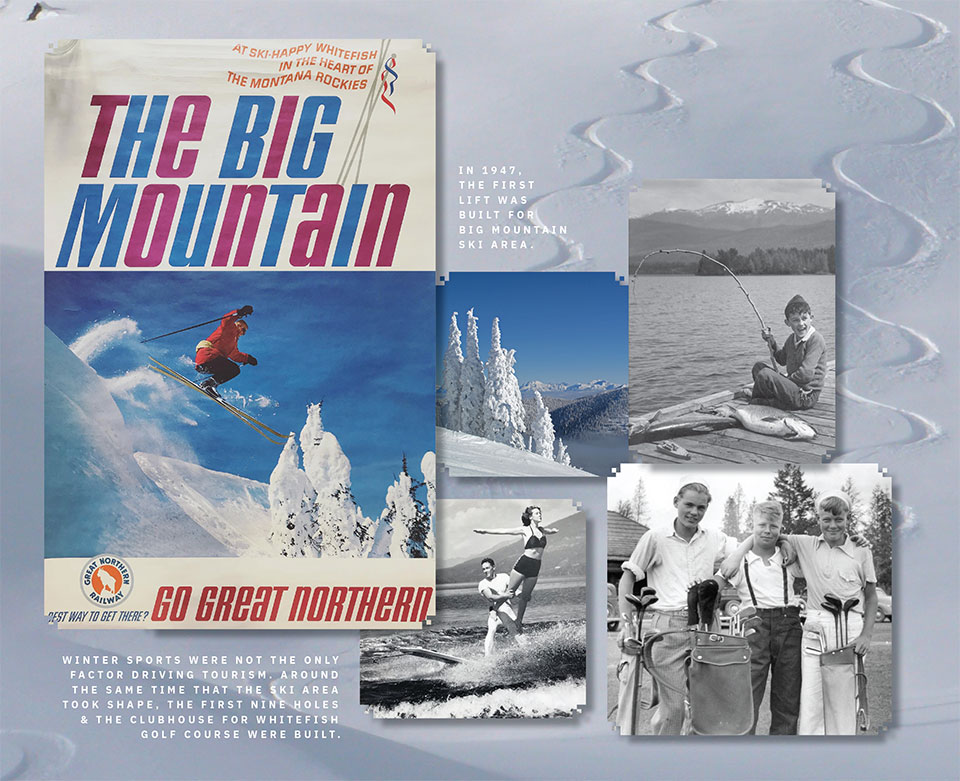
BECOMING A RESORT TOWN
For the next 50 years, lumber, agriculture, and the railroad drove Whitefish’s economy, but by the middle of the 20th century, the local economy was starting to turn toward tourism. The early stages of Whitefish’s resort economy began to take shape. More summer cabins sprinkled the shores of Whitefish Lake, while logging slowed and railroad jobs were replaced with automated machinery from a modernizing world.
In 1947, the first lift was built for Big Mountain Ski Area. Since the ‘30s and ‘40s, local skiers had been hiking and skiing down Hellroaring Mountain, and the new lift meant more access into Hellroaring Basin. After 60 years and the addition of 10 chairs, Big Mountain was renamed Whitefish Mountain Resort in an effort to drive awareness for the small town where it was located.
Winter sports were not the only factor driving tourism. Around the same time that the ski area took shape, the first nine holes and the clubhouse for Whitefish Golf Course were built. It became an 18-hole course in the early ‘60s and nine more holes were added in the ‘90s, making it the largest golf course in the state.
BOOMTOWN TO ZOOMTOWN
While railroad and logging jobs initially brought people to Whitefish, Kalispell, and the greater Flathead Valley, the U.S. Census showed steady growth from 2000 to 2010. Many of Whitefish’s new residents during that time came for retirement and recreation. The most dramatic growth began in 2020 during COVID. Montana’s low population density and access to nature offered the peace of mind many coming from larger cities sought during the pandemic.
Since the most recent census in 2020, the population of Whitefish has increased by almost 27%. The median home price for July 2023 was $1.5M, trending up 23% y/y. Last year, Ski magazine called Whitefish a “paradise in balance.”
Like many of our country’s best-kept-secret ski towns, the influx of non-resident wealth is precluding locals – the locals who not just work in restaurants but also nurses, teachers, and other professionals who are integral community members – from being able to afford a home in town.
Whitefish is aware that it has an affordable housing crisis, and local businesses are trying to solve the problem by offering employee housing. Additionally, a new multifamily development called the Whitefish Corridor Community was recently greenlit. There are sustainable tourism initiatives and a Tourism Advisory Council, but land is king in Montana, and property owners are seeing healthy returns by offering vacation rentals to tourists who may fall in love with the place and become future residents.
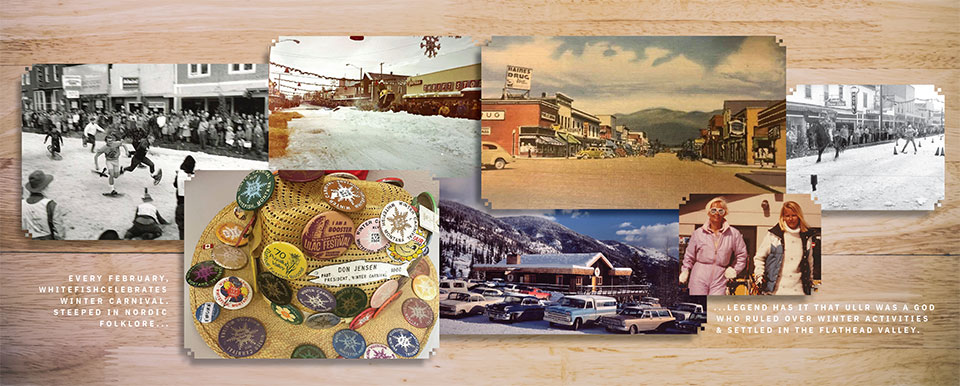
THE FUN OF WHITEFISH
Part of what makes Whitefish so special is how old buildings are kept alive and given new uses. The Old Saddle Club building on Wisconsin Avenue was a former arena for roping and skijoring. Today it houses the Ski Heritage Center’s Museum of Skiing and is conveniently located on the way up to the mountain. Next door to the ski museum, Stumptown Ice Den is the only rink in Montana that stays open 12 months a year. It’s a modern facility for both hockey and figure skating and it welcomes 1,000 regular youth and adult participants each year, not to mention that it hosts an annual NHL prospects camp.
Like much of Montana, Whitefish is an outdoor recreation lover’s paradise. In addition to skiing and snowboarding on the mountain in the winter and easily accessible forests for other winter sports, there is boating, paddling, floating, and fishing in the summer, and hiking and biking opportunities abound right in town. The Whitefish Trail links 42 miles of trails for hiking, biking, running, dog walking, and horseback riding from downtown Whitefish out to Beaver Lake. Soccer is a large part of the community as well. Local philanthropists generously donated to make possible the Smith Fields Sports Complex, soccer fields that serve 600 North Valley families and have hosted the State Championships.
Also in town every February, the Whitefish Winter Carnival is a big hit steeped in Nordic folklore. Legend has it that Ullr was a god who ruled over winter activities and settled in the Flathead Valley. He had a queen and a prime minister, and there was a band of Yetis – yes, aggressive snowmen – who threatened the kingdom and tried to kidnap his queen. Every year, the Yetis get bolder but remain unsuccessful in trying to overthrow Ullr’s kingdom. Events include a coronation, skijoring, a parade, and a penguin plunge in the icy waters of Whitefish Lake. Formerly a sleepy town in the summer, since 2019, Whitefish’s Big Mountain Ranch has hosted Under the Big Sky, an annual country music festival and rodeo that drew over 20,000 people last year.
Aside from festivals that draw tourism, there are a host of performing arts venues and production companies offering year round theater. The Whitefish Theater Company and the Alpine Theater Project (ATP), the latter of which was founded by three Broadway veterans, offer world class performance in town. ATP’s artists have performed in over 190 Broadway productions, won four Tony Awards, seven Emmy Awards, four Golden Globe Awards, and an Academy Award, and it has received notice from the New York Times and Los Angeles Times.
New developments in Whitefish offer the prospect of more sustainable growth both on and off the mountain. From vacation homes at the Lodge at Whitefish Lake and Landmark at Whitefish Resort to rugged and secluded lots overlooking either Flathead or Whitefish Lake, the Flathead Valley offers the prospect of living in extraordinary beauty. Although today’s Whitefish looks nothing like the town of 10 or 20 years ago and is much more polished than the rugged frontier days, it still is one of the last best places.
